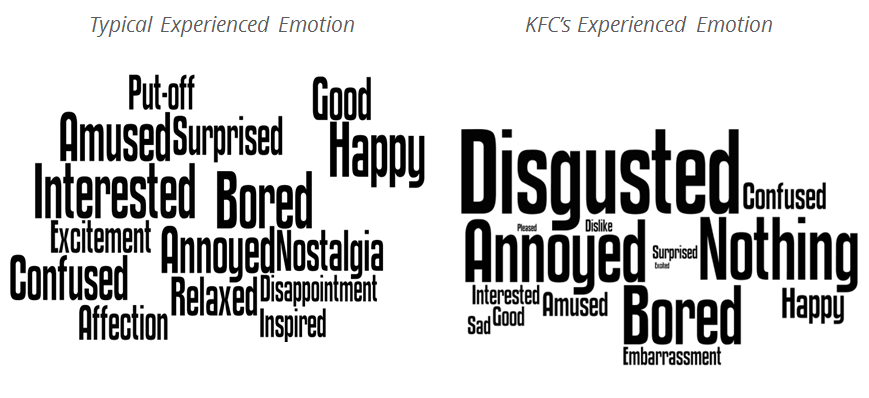Which Emotions do Ad Viewers Experience?
Posted: 29/09/2017

Marmite, Pot Noodle, and KFC. Either a terrible student dinner party or three of the UK’s most complained about adverts1.
KFC’s 2005 ad, featuring call-centre workers singing with their mouths full, for example, received a record 1,671 complaints. KFC countered that they were trying to be funny and, charitably, they may also have been trying to court controversy. But the ad never re-aired and the Brand Director left. Clearly it’s never obvious how audiences will respond. But that’s why there are pre-tests. How did KFC’s pre-testing fail to flag the scale of the negative reaction?
In a previous post we discussed the nature of emotion. We know that all emotions can be described as feeling negative or positive and passive or adrenalised. But the same core affect can be experienced as different emotions. ‘Disgust’ is a negative and slightly adrenalised emotion, as are ‘frustration’ and ‘irritation’. But each carries a different brand implication and requires a different solution if they are to be avoided.
The challenge faced by standard testing is that there are just too many experienced emotions to track. A typically Ad Test provider will look for about 10-20, not including ‘disgust’ apparently, but the English language contains about 3,000 emotions. And that’s not including the emotions identified by other languages, like the ‘schadenfreude’ or ‘pena ajena’ we might feel on hearing that KFC has just fired its ad-test provider2.

To address this problem, we’ve developed an emotional processor that can categorise people’s spontaneous responses into a given set of experienced emotion. The graphic shows the 15 emotions that a typical advert generates. To the earlier point, we find that about 100-150 different emotions are generated across a range of adverts, rather than 10-20.
KFC is a case in point. This advert elicits much more disgust, indifference and dislike than a typical advert. So using this approach, KFC could have detected the problem and avoided the bad publicity by pulling, editing or re-positioning the ad.
Indeed, with better informed and targeted media buying, this advert could have been the viral student hit of 2005, enjoyed and discussed over numerous rounds of Marmite on toast.
1. Marmite: https://www.youtube.com/watch?v=Iz6n7j5GguM; Pot Noodle:https://youtu.be/ub02d_4q5x0; KFC: https://www.youtube.com/watch?v=imIkeTkAopY
2. ‘Schadenfreude’ (German) is the pleasure derived from someone else’s pain and ‘pena ajena’ (Mexican) is the embarrassment you feel watching someone else’s humiliation